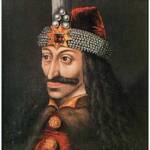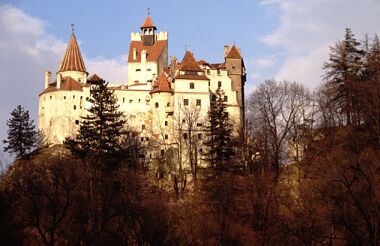Dracula's Castle
498, Traian Mosoiu St, Bran
Dracula's Castle is situated between Bucegi and Piatra Craiului Mountains, right where you enter Rucar-Bran Pass. It is the same with Bran Castle.
History
The first documentary attestation of Bran Castle is the letter written in 1377 by the Hungarian Ludovic I D'Anjou, giving the inhabitants of Brasov some privileges.
At the end of the 14th century, king Sigismund gave up the leadership of Bran Fortress in favor of Mircea cel Batran. The royal domain had been given to the Hungarian aristocracy, while the fortress passed under the rule of Mircea's faithful boyars. Few years later, the Hungarian king got back the fortress. Bran Fortress was subordinated to the authority of Szeklers Committee.
The Fortress had an essential role in protecting the Hungarian king from the Ottomans and Tartars' invasion, coming from Wallachia through Rucar Pass. That's the reason why the inhabitants of Brasov built the Castle on their own work and expenses.
Iancu de Hunedoara fortified Transylvania's borders and also the towers of the Bran Castle. He made sure the rights of the peasants were respected by the boyars who ruled the fortress. However, there were frequent fights between merchants and boyars.
In 1498 the fortress passed under the merchant's possession and it was used mainly for trading. You should also know that it was a time when in charge of the leadership was a judge called "Judele Brasovului". Responsible for the defense of the castle was the permanent garrison: 2 guards and 10 - 20 archers and ballisters.
The boyars. had the right to collect fees from visitors and peasants. The fortress had an extra income from: selling cheese, milk and muttons and from manufacturing wood. The peasants fought against the aristocracy for several times. In 1514 they refused to take action against Gheorghe Doja.
In the 18th century the fortress was the house of the Austrians frontier guards. In 1836 Bran became the official border and the defense role of the fortress was no longer a priority. In 1920, the Brasov Town council donated Ban Castle to Queen Maria of Great Romania, who lived there with the royal family till 1947. Since 1947 the Castle is opened as a museum.
Architecture
The building of Bran Castle started somewhere around the year 1378. The constructors somehow succeeded in combining wood with the rock brought from Magura Branului.
The castle had a protective and commercial purpose. It had two rows of walls closing the passing towards South. They were made in stone and brick. Only few traces of the initial defense position still exist.
The undersized building of the ancient Post Office had a pit with 6-8 rooms and a cellar also used as prison. It hasn't been preserved.
At that time the fortress comprised the exterior wall, the donjon, the round tower and the gate's tower. The wall was built in stone blocks and bricks and had rectangular fire holes as had all Transylvanian fortresses. The donjon was located on the North side and comprised four floors and only two chambers. On the top there was an observation point. Since 1593 the round tower has a circular section. At its pit the ancient inhabitants used to deposit the gun powder. The first and the second floor comprised few chambers. Initially the gate's tower was round, but it was rebuilt in 1625 in rectangular shape. The ancient gate was blocked with beams. The only way of reaching this entrance was by climbing up a ladder. Inside the courtyard you can still see the initial well (57 m high).
While centuries passed by changes have been made to the castle. In the 16th century the wax-paper from the windows was replaced with glass and the shingle from the roof with tile. Many of the changes and reparations have been made by the prince Gabriel Bethlen. He added another rectangular tower, a square tower with two floors and the actual gate. The old observatory tower, dated 1622, shows the Romanian architectural style. At that time the villagers's houses were located on the North side of the castle. On the first floor there was a vestibule, a big dinning room, a kitchen and under the stairs a small room where they kept the gun powder. The second level comprised also a vestibule, a small chamber with a door towards the new tower, a room with short beams, a small room and a corridor made in wood (the exit towards the courtyard).
During 1920-1930 other changes have been made. The fire holes turned into windows, the well into the elevator's room and the stoves into fireplaces. There have been added towers to the stairs and it was built in wood the fourth floor.
Many legends are connected with Bran Castle. It is said the castle belonged to Count Dracula (Vlad Tepes), but nobody has any proof. Vlad Tepes lived only for a short time in the castle and only as a guest. What is really true is that Bran Castle conjures up the perfect Gothic fairy-tale image of a Transylvanian castle and as a result draws crowds of tourists from far and wide.
Dracula's Castle - The Legend
In 1897 Bram Stoker wrote a terrifying story about Count Dracula. A century after, there are still people who believe in it. Even researchers are trying to find out the truth about Dracula. All are trying to clear the mystery: was there or wasn't there a vampire in Transylvania?
How many of these fabulous stories are legends and how many say the truth ? Here is the legend about Dracula.
Stoker's story is based on the life of Vlad Tepes/Vlad the Impaler (1431-1476), a ruler revered by Romanians for standing up to the Ottoman Empire. Known as one of the most dreadful enemies of the Turks, Vlad started organizing the state and enforcing the law by applying death penalty and impaling all those he considered enemies: robbers, cunning priests, treacherous noblemen, beggars, usurper Saxons. In fact he fought against everybody who tried to replace him either by his step brother Vlad the Monk or by his cousin Dan the Young. The historians nicknamed him Vlad Tepes while people say he was Count Dracula because he used to sign with his father's name, Dracul "The Devil". Dracula is derived from the Romanian word for devil or dragon.
This word alone carries with it magic and mystery.
His castle is supposed to be Bran's Castle since its narrow corridors constitute a mysterious labyrinth of ghostly nooks and secret chambers easy to hide a "vampire".
The Dracula's Castle was built on the edge of the Bran Pass and nowadays lures guests worldwide who wish to partake in the legend of the Count Dracula.
Who was Vlad Tepes ?
VLAD TEPES/The Impaler (DRACULA)
Prince of Wallachia (1448,1456-1462,1476)
Son of Vlad Dracul (Knight of the Order of the Dragon- since his nickname Dracul, meaning 'dragon', 'devil' in Romanian-in 1431) and Grandson of Mircea the Great, King of Wallahia (1386-1418)
Vlad Tepes introduced a very strict order in Wallachia, strengthened the army, helped the trade with the neighboring countries and was merciless towards those who went against him. He adopted a totalitarian leadership and fought against The Ottoman Empire scoring many victories.




